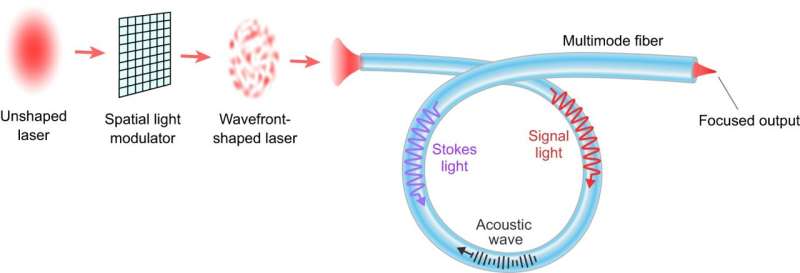This article has been reviewed according to Science X's editorial process and policies. Editors have highlighted the following attributes while ensuring the content's credibility:
fact-checked
peer-reviewed publication
trusted source
proofread
High-power fiber lasers emerge as a pioneering technology

Optical scientists have found a new way to significantly increase the power of fiber lasers while maintaining their beam quality, making them a future key defense technology against low-cost drones and for use in other applications such as remote sensing.
Researchers from the University of South Australia (UniSA), the University of Adelaide (UoA) and Yale University have demonstrated the potential use of multimode optical fiber to scale up power in fiber lasers by three-to-nine times but without deteriorating the beam quality so that it can focus on distant targets.
The breakthrough is published in Nature Communications.
Co-first author Dr. Linh Nguyen, a researcher at UniSA's Future Industries Institute, says the new approach will allow the industry to continue squeezing out extremely high power from fiber lasers, make them more useful for the defense industry, and for remote sensing applications and gravitational wave detection.
"High-power fiber lasers are vital in manufacturing and defense, and becoming more so with the proliferation of cheap, unmanned aerial vehicles (drones) in modern battlefields," Dr. Nguyen says.
"A swarm of cheap drones can quickly drain the missile resource, leaving military assets and vehicles with depleted firing power for more combat-critical missions. High-power fiber lasers, with their extremely low-cost-per-shot and speed-of-light action, are the only feasible defense solution in the long run.
"This is known as asymmetric advantage: a cheaper approach can defeat a more expensive, high-tech system by playing the large number."
In delivering an asymmetric advantage this advanced capability has the potential to provide a strong deterrent effect, aligning well with the objectives of the Defense Strategic Review and AUKUS Pillar 2 objectives.
Dr. Ori Henderson-Sapir, project investigator at the UoA's Institute for Photonics and Advanced Sensing, says that Australia has a long history of developing innovative fiber optics technologies.
"Our research launches Australia into a world-leading position to develop the next generation of high-power fiber lasers, not only for defense applications, but to aid new scientific discoveries."
The researchers have demonstrated the technology in fiber lasers and will report their findings at Photonics West held in San Francisco in early 2024.
More information: Chun-Wei Chen et al, Mitigating stimulated Brillouin scattering in multimode fibers with focused output via wavefront shaping, Nature Communications (2023). DOI: 10.1038/s41467-023-42806-1
Journal information: Nature Communications
Provided by University of South Australia



















